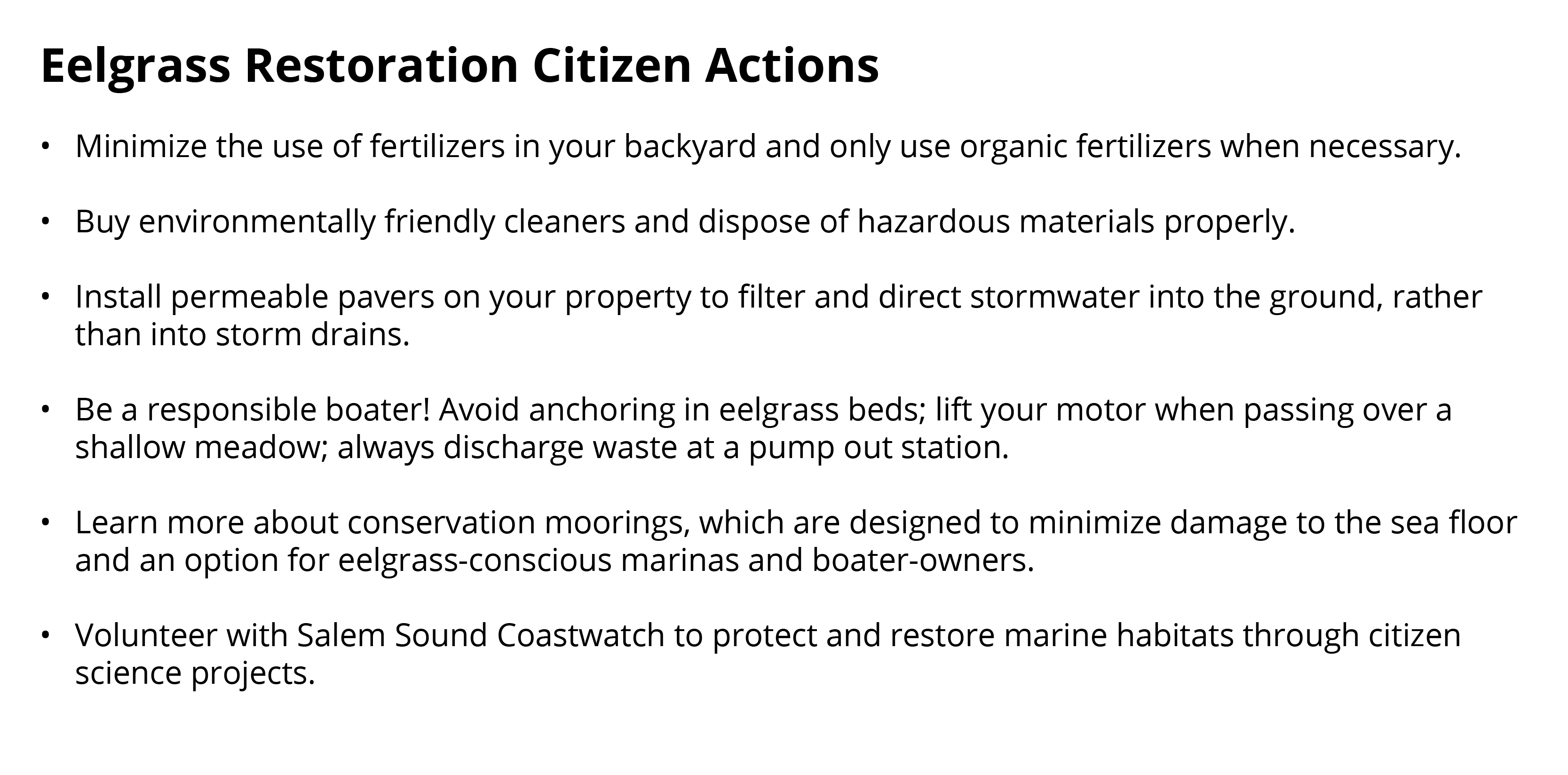Eelgrass Restoration
Eelgrass Meadows
Eelgrass meadows provide important services for the ecosystem’s health, as well as coastal communities. Despite its values, eelgrass habitat is declining. Eelgrass meadows are federally protected as an “Essential Fish Habitat” and a “Habitat of Particular Concern,” and as such, many restoration and conservation efforts have taken place in order to re-establish this important natural resource in The Sound.
Community Science
iSeaGrass is a community science project where volunteers monitor the extent and condition of eelgrass in Salem Sound. A camera attached to a PVC frame is lowered from a boat to help scientists map the locations and health of eelgrass in our area. The photos are also used to measure water depth and clarity.
To the right: Citizen scientist volunteers monitor Salem Sound eelgrass and collect specimen samples.


Eelgrass Restoration
Planting efforts have taken place in Juniper Point and Fort Pickering in Salem, as well as off Woodbury Point in Beverly. Volunteers thread eelgrass shoots through burlap disks, called “tortillas.” The eelgrass tortillas are then planted by DMF divers at locations that need extra support, where they will reestablish and promote further growth.


Above: A teacher shows students specimens of local Salem Sound eelgrass.
To the left: School to Sea Healthy Harbors students and teachers spend a day planting eelgrass in the shallow waters of Essex Bay with the Massachusetts Bay Partnership.
Traditionally, eelgrass restoration has been conducted by transplanting adult shoots to rebuild eelgrass beds, such as the “tortilla” method, above. Although this method has shown success, it can be expensive and time consuming to restore eelgrass on even a small scale with this approach. In an effort to restore eelgrass on a larger scale within Salem Sound, we partnered with the Massachusetts Bay National Estuary Partnership (MassBays) to restore eelgrass using a seed-based approach, where eelgrass seeds are planted at a restoration site instead of whole shoots. A pilot restoration site was planted off the coast of Beverly, at Dane Street Beach and Lynch Park, using this new seed-based approach. At these two sites, over 20,000 seeds were planted in biodegradable bags, which were prepared by Salem Sound Coastwatch volunteers. Using snorkel gear, SSCW staff then planted the seed bags in marked plots to allow for future monitoring of the project’s success.

What can you do to protect eelgrass beds?
Eelgrass Studies
Ongoing eelgrass studies that aim to improve conservation and restoration efforts are also taking place. Salem Sound Coastwatch partnered with MassBays National Estuary Partnership and Massachusetts Office of Coastal Zone Management (CZM) to map eelgrass beds along the coast of Massachusetts. The study, titled “A Comparison of Eelgrass Mapping Methods,” utilized various survey methods, such as satellite imagery, drone footage, and side-scan sonar, to determine the accuracy of different methods. The results of this study were recently published by Jill Carr (MassBays) and Todd Callaghan (CZM) in the scientific journal, Geosciences, which can be found here.
We have also studied the effect floating docks have on eelgrass beds along Marblehead’s west shore. In this study, Salem Sound Coastwatch and the Massachusetts Division of Marine Fisheries (DMF) used sensors under docks to measure the available light. Divers then recorded the amount of eelgrass under and surrounding the docks. The results of this study indicate that floating docks block a significant amount of light and reduce eelgrass’ ability to grow.
Current research investigates new methods of restoration, such as the role that eelgrass seeds can play in restoration efforts. Salem Sound Coastwatch partnered with MassBays and MA DMF scientists on a study titled, “Modeling and piloting a new seed-based approach to large-scale eelgrass restoration in Massachusetts.” This study is funded by the Woods Hole Oceanographic Institution SeaGrant to investigate the use of harvested eelgrass seeds, rather than transplanted shoots, to restore eelgrass beds in Massachusetts. Salem Sound Coastwatch is leading the seed viability and field germination experiments, as well as the community education for this study.


